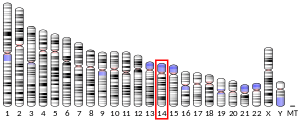CHMP4A
Charged multivesicular body protein 4a is a protein that in humans is encoded by the CHMP4A gene.[3]
References
- ENSG00000285302 GRCh38: Ensembl release 89: ENSG00000254505, ENSG00000285302 - Ensembl, May 2017
- "Human PubMed Reference:". National Center for Biotechnology Information, U.S. National Library of Medicine.
- "Entrez Gene: CHMP4A chromatin modifying protein 4A".
External links
- Human CHMP4A genome location and CHMP4A gene details page in the UCSC Genome Browser.
- Human CHMP4B genome location and CHMP4B gene details page in the UCSC Genome Browser.
Further reading
- Zhang QH, Ye M, Wu XY, et al. (2001). "Cloning and functional analysis of cDNAs with open reading frames for 300 previously undefined genes expressed in CD34+ hematopoietic stem/progenitor cells". Genome Res. 10 (10): 1546–60. doi:10.1101/gr.140200. PMC 310934. PMID 11042152.
- Strausberg RL, Feingold EA, Grouse LH, et al. (2003). "Generation and initial analysis of more than 15,000 full-length human and mouse cDNA sequences". Proc. Natl. Acad. Sci. U.S.A. 99 (26): 16899–903. doi:10.1073/pnas.242603899. PMC 139241. PMID 12477932.
- Katoh K, Shibata H, Suzuki H, et al. (2003). "The ALG-2-interacting protein Alix associates with CHMP4b, a human homologue of yeast Snf7 that is involved in multivesicular body sorting". J. Biol. Chem. 278 (40): 39104–13. doi:10.1074/jbc.M301604200. PMID 12860994.
- Strack B, Calistri A, Craig S, et al. (2003). "AIP1/ALIX is a binding partner for HIV-1 p6 and EIAV p9 functioning in virus budding". Cell. 114 (6): 689–99. doi:10.1016/S0092-8674(03)00653-6. PMID 14505569.
- von Schwedler UK, Stuchell M, Müller B, et al. (2003). "The protein network of HIV budding". Cell. 114 (6): 701–13. doi:10.1016/S0092-8674(03)00714-1. PMID 14505570.
- Martin-Serrano J, Yarovoy A, Perez-Caballero D, et al. (2003). "Divergent retroviral late-budding domains recruit vacuolar protein sorting factors by using alternative adaptor proteins". Proc. Natl. Acad. Sci. U.S.A. 100 (21): 12414–9. doi:10.1073/pnas.2133846100. PMC 218772. PMID 14519844.
- Peck JW, Bowden ET, Burbelo PD (2004). "Structure and function of human Vps20 and Snf7 proteins". Biochem. J. 377 (Pt 3): 693–700. doi:10.1042/BJ20031347. PMC 1223912. PMID 14583093.
- Katoh K, Shibata H, Hatta K, Maki M (2004). "CHMP4b is a major binding partner of the ALG-2-interacting protein Alix among the three CHMP4 isoforms". Arch. Biochem. Biophys. 421 (1): 159–65. doi:10.1016/j.abb.2003.09.038. PMID 14678797.
- Gerhard DS, Wagner L, Feingold EA, et al. (2004). "The status, quality, and expansion of the NIH full-length cDNA project: the Mammalian Gene Collection (MGC)". Genome Res. 14 (10B): 2121–7. doi:10.1101/gr.2596504. PMC 528928. PMID 15489334.
- Lin Y, Kimpler LA, Naismith TV, et al. (2005). "Interaction of the mammalian endosomal sorting complex required for transport (ESCRT) III protein hSnf7-1 with itself, membranes, and the AAA+ ATPase SKD1". J. Biol. Chem. 280 (13): 12799–809. doi:10.1074/jbc.M413968200. PMID 15632132.
- Rual JF, Venkatesan K, Hao T, et al. (2005). "Towards a proteome-scale map of the human protein-protein interaction network". Nature. 437 (7062): 1173–8. doi:10.1038/nature04209. PMID 16189514.
- Tsang HT, Connell JW, Brown SE, et al. (2006). "A systematic analysis of human CHMP protein interactions: additional MIT domain-containing proteins bind to multiple components of the human ESCRT III complex". Genomics. 88 (3): 333–46. doi:10.1016/j.ygeno.2006.04.003. PMID 16730941.
- Fisher RD, Chung HY, Zhai Q, et al. (2007). "Structural and biochemical studies of ALIX/AIP1 and its role in retrovirus budding". Cell. 128 (5): 841–52. doi:10.1016/j.cell.2007.01.035. PMID 17350572.
- Shim S, Kimpler LA, Hanson PI (2007). "Structure/function analysis of four core ESCRT-III proteins reveals common regulatory role for extreme C-terminal domain". Traffic. 8 (8): 1068–79. doi:10.1111/j.1600-0854.2007.00584.x. PMID 17547705.
This article is issued from Wikipedia. The text is licensed under Creative Commons - Attribution - Sharealike. Additional terms may apply for the media files.

